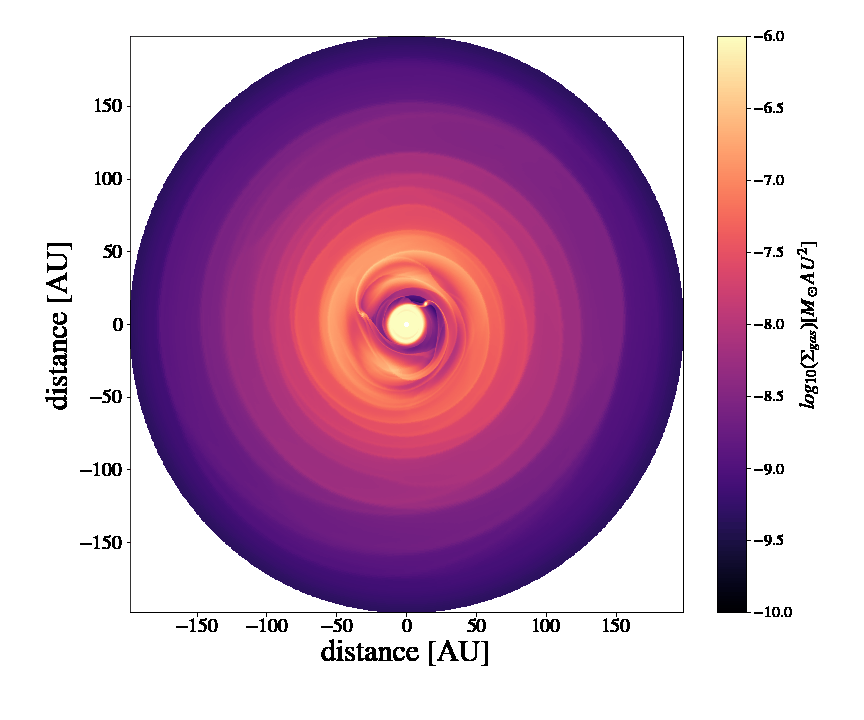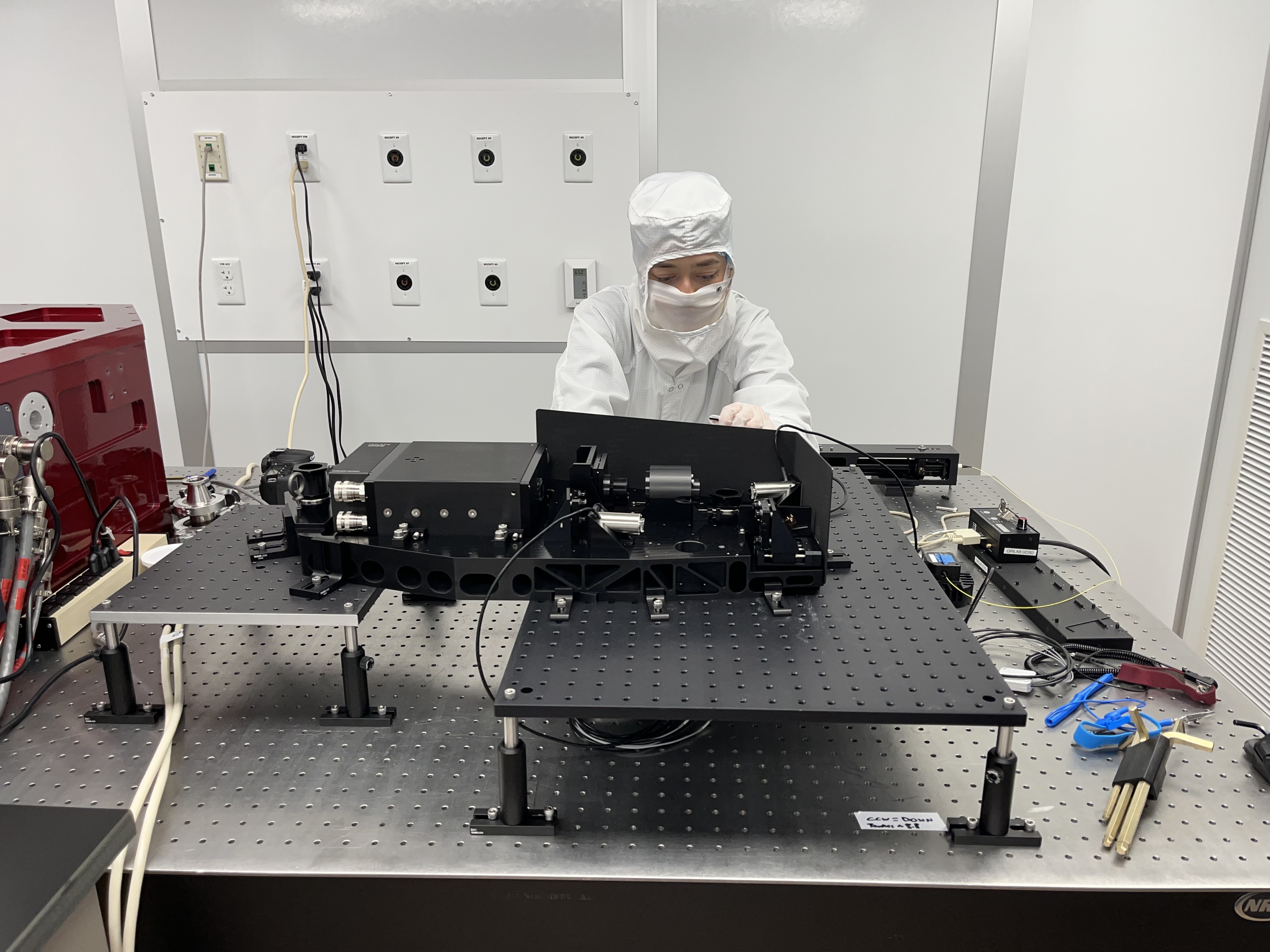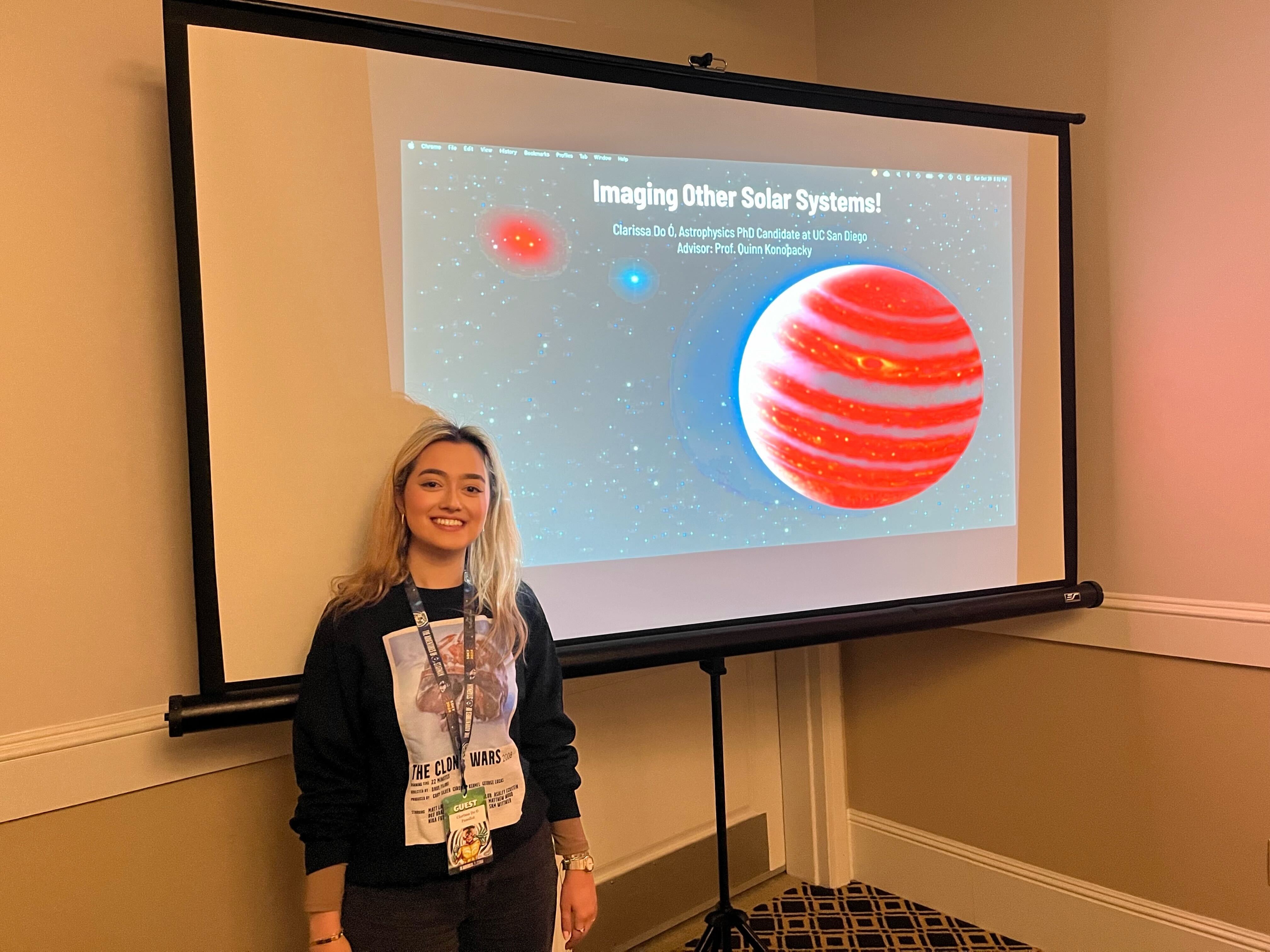About Me
Hi! My name is Clarissa Do Ó and I am a fifth (and final!) year Ph.D. candidate at UC San Diego Astrophysics, under the National Science Foundation and San Diego Fellowships.
At UCSD, I am working with Prof. Quinn Konopacky on the Gemini Planet Imager's (GPI) adaptive optics upgrade and on studying the orbit fitting and dynamics of exoplanet systems.
I earned my B.S. in Physics at UC Santa Barbara with a minor in Astronomy and Planetary Science. At UCSB, I worked with Prof. Ben Mazin on the MKID Exoplanet Camera (MEC) data reduction pipeline.
My research interest is in understanding the formation of widely separated gas giant planets ("exo-Jupiters").
In order to understand giant planet formation processes, I employ a variety of methods, such as using observational data from telescopes to characterize their orbits and atmospheres,
simulating the dynamics of forming planets using our current theoretical models, and
upgrading instruments that will allow for the detection of more exoplanets (to see my specific projects, please go to my Research tab).
I grew up in São Paulo, Brazil, which is where I fell in love with astronomy after visiting the Ibirapuera Planetarium as a kid. Outside of the lab, I am passionate about coffee (most recently, I've also been interested in matcha), ice skating, and Star Wars.

This is me observing with Keck's NIRC2 for some of my exoplanet orbit work!

And visiting the summit of Mauna Kea in Hawaii, where I got to see the Keck Observatory up close!

Research
I am interested in the intersection of exoplanet instrumentation, observations and theory - all to understand planet formation (mostly from a dynamical perspective)!
Detecting widely separated giant planets involves developing cutting-edge instruments that allow us to image them.
Here, I wrote a small summary of what are my interests and what I am currently working on for research. You can find my co-authored publications below.
ADS
Google Scholar
Exoplanet Orbits & Dynamics
Statistical Study of Planet Populations from Orbit Fitting
Using astrometry and radial velocitiy measurements of directly imaged exoplanets, it is possible to fit for these planets' orbits in order to constrain their orbital parameters.
However, many of these planets have long periods (10s-1000s of years long!), which means that we have a low phase coverage of their orbital arcs.
This low coverage can lead to biases in their parameters from the orbit fits.
I used observable-based priors - a new approach to orbit fitting which aims to reduce the parameter bias in low phase coverage orbits - to analyze the eccentricity of exoplanets at a population level.
Understanding the eccentricity distributions of exoplanets can shed light on how they were formed. This work has been published in The Astronomical Journal. IOP ADS
 Eccentricity posteriors of the HD 1160 b companion with 3 different priors+data combination.
Eccentricity posteriors of the HD 1160 b companion with 3 different priors+data combination.
High Resolution Spectroscopy to obtain Planet Radial Velocities
Radial velocities from high resolution spectroscopy are useful for eliminating degeneracies in orbit fitting, because they provide a third dimension of information to orbit fitting. In particular,
they can remove the degeneracy between the longitude of ascending node (Ω) and the argument of periapsis (ω), as well as helping with the eccentricity-inclination degeneracy of orbits. The companion to the 1RXS J034231.8+121622 system presented an unconstrained orbit fit.
I used high resolution spectroscopy from the Keck Planet Imager and Characterizer (KPIC) and a new astrometric measurement from Keck/NIRC2 to re-calculate the system's mass and orbit, finding a better constrained orbit for the companion.
This work has been published in The Astronomical Journal. IOP ADS
 Visual orbit comparison for two different mass estimates for the 1RXS J034231.8+121622 system.
Visual orbit comparison for two different mass estimates for the 1RXS J034231.8+121622 system.
Orbital and Hydrodynamic Simulations of Protoplanetary disks
I have begun tests to analyze how the eccentricities of protoplanets change with time using current theoretical models for planet formation.
Forming planets are still embedded in
their protoplanetary disk. The goal is to use orbital dynamics and hydrodynamic simulations to analyze how the formation process affects young planets' orbital architectures!
 Hydrodynamic + N-body simulations of a forming planet system from my simulations.
Hydrodynamic + N-body simulations of a forming planet system from my simulations.
Stability of Exoplanet Systems
Using astrometry for orbit fits and N-Body simulations, I am interested in constraining the stability of exoplanet systems. One system I am currently studying is HR 8799, the only directly imaged system with 4 gas giants. The HR 8799 system planets are believed to be coplanar and in 1:2:4:8 mean-motion resonance (MMR).
Understanding the dynamics of exoplanet systems becomes important for understanding their formation as well as the long-term stability as new candidate planets are imaged in multiple-planet systems. This work has been published in The Astronomical Journal. IOP ADS
 Direct imaging of the HR8799 System. Credit: Jason Wang/Christian Marois.
Direct imaging of the HR8799 System. Credit: Jason Wang/Christian Marois.
Instrumentation
GPI 2.0
Currently, many of our observations for exoplanet detection are ground based (our Telescopes are on Earth and not in space).
This means that the Earth's atmosphere can interfere on our images due to its turbulence.
The atmosphere severely limits the power of large telescopes, because it distorts the incoming light (called a wavefront), generating something called wavefront error.
This limitation led astronomers to develop a technology called adaptive optics (AO), which uses deformable mirrors to correct the turbulences introduced by the Earth's atmosphere (or correct for the wavefront error).
The adaptive optics technology is constantly being improved, and is essential for ground based instruments that are searching for exoplanets.
I am working on the upgrade of the Gemini Planet Imager's (GPI) wavefront sensor. The upgrade involves building and testing a pyramid wavefront sensor.
I have built the test source unit (TSU) for the wavefront sensor, which will allow us to test for the system's alignment.
I have also tested the wavefront sensor's detector, an EMCCD camera - checking for its noise contributors and overall functionality. GPI 2.0 will be assembled and installed at Gemini North.
These upgrades will allow us to find new exoplanets and to obtain high quality data on already known planets.
I have an AO4ELT Proceeding on the test results for GPI 2.0's wavefront sensor EMCCD. HAL arXiv
I also have an SPIE Proceeding on the test results to improve the wavefront sensor's camera image quality. SPIE arXiv
 This is me aligning the TSU for the pyramid wavefront sensor (which you can see in front of me on the optical bench).
This is me aligning the TSU for the pyramid wavefront sensor (which you can see in front of me on the optical bench).
Resources
UCSD Cohort Mentoring Program
This program is run by the UCSD Physical Sciences and is a great resource for undergraduate students. In this program,students have the
opportunity to be mentored by graduate students both on school work and on job and graduate school applications. I was a Cohort Program Mentor from 2022-2023
and really enjoyed mentoring some very brilliant students!
The NYRIA Collaboration
The Network of Young Researchers in Instrumentation for Astronomy (NYRIA) is an international network of early career researchers (grad students and postdocs) working on
astronomical instrumentation. Every year, members of NYRIA host a week long workshop where members get to network, give talks and learn about career pathways.
In 2024, I had the privilege to be part of the Local Organizing Committee (LOC) organizing and hosting NYRIA at UC San Diego. Some photos are below!
 The NYRIA LOC!
The NYRIA LOC!
UCSD STARTastro Program
This program is run by the UCSD Astronomy Department and is a great resource for community college transfer students. In this program, transfer students have the opportunity to
pursue summer research the summer before they transfer to a 4 year University. I was a STARTastro Program Mentor in 2024, and it allowed me to foster collaborations with a student that I am still working with!
USD Physics Identity Program
This program is run by a University of San Diego (USD) Physics Department professor and is a great resource for undergraduates seeking career guidance from peers.
In this program, graduate students from the San Diego area are paired with USD undergraduates. I am currently mentoring a student on graduate school applications through this program.
NASA ExoExplorers
As a NASA ExoExplorer, graduate students and postdocs
get to participate in workshops, professional development sessions and get to give a talk to the broader exoplanet community. This program is an excellent professional development
opportunity for early career scientists in the exoplanet field.
Outreach
Astrobites & Astropontos
Astrobites is a website where graduate students from all over the world post summaries of astrophysics papers from arXiv. The website also includes posts on outreach, scholarships, careers in astronomy and more.
I joined Astrobites in 2022 as an author. I am also joining Astropontos, its sister website in Portuguese.
Cosmic Tours
The UCSD Cosmic Tours are short planetarium shows given on a portable planetarium for K-12 schools and other outreach events. In the shows, spectators can travel across the Solar System and beyond to learn more about our Universe.
I currently volunteer and am a co-coordinator for Cosmic Tours. If you are interested in hosting shows at your school, please reach out to me or to the Cosmic Tours email!
Public Talks
I had the privilege of giving several public outreach talks throughout my Ph.D! Special highlights include the
iTelescope talk on exoplanet dynamics and a more sci-fi oriented
talk about exoplanets at the San Diego Comic Fest (see picture below)!

Young Scientists Club
The Young Scientists Club is a series of science lectures and experiments for kids grades 3-6. The students participate in hands-on experiments on optics, fluid properties and more as they learn more about the physics concepts behind the experiments. I currently volunteer for the Young Scientists Club.
Contact
Elements
Text
This is bold and this is strong. This is italic and this is emphasized.
This is superscript text and this is subscript text.
This is underlined and this is code: for (;;) { ... }. Finally, this is a link.
Heading Level 2
Heading Level 3
Heading Level 4
Heading Level 5
Heading Level 6
Blockquote
Fringilla nisl. Donec accumsan interdum nisi, quis tincidunt felis sagittis eget tempus euismod. Vestibulum ante ipsum primis in faucibus vestibulum. Blandit adipiscing eu felis iaculis volutpat ac adipiscing accumsan faucibus. Vestibulum ante ipsum primis in faucibus lorem ipsum dolor sit amet nullam adipiscing eu felis.
Preformatted
i = 0;
while (!deck.isInOrder()) {
print 'Iteration ' + i;
deck.shuffle();
i++;
}
print 'It took ' + i + ' iterations to sort the deck.';
Lists
Unordered
- Dolor pulvinar etiam.
- Sagittis adipiscing.
- Felis enim feugiat.
Alternate
- Dolor pulvinar etiam.
- Sagittis adipiscing.
- Felis enim feugiat.
Ordered
- Dolor pulvinar etiam.
- Etiam vel felis viverra.
- Felis enim feugiat.
- Dolor pulvinar etiam.
- Etiam vel felis lorem.
- Felis enim et feugiat.
Icons
Actions
Table
Default
| Name |
Description |
Price |
| Item One |
Ante turpis integer aliquet porttitor. |
29.99 |
| Item Two |
Vis ac commodo adipiscing arcu aliquet. |
19.99 |
| Item Three |
Morbi faucibus arcu accumsan lorem. |
29.99 |
| Item Four |
Vitae integer tempus condimentum. |
19.99 |
| Item Five |
Ante turpis integer aliquet porttitor. |
29.99 |
|
100.00 |
Alternate
| Name |
Description |
Price |
| Item One |
Ante turpis integer aliquet porttitor. |
29.99 |
| Item Two |
Vis ac commodo adipiscing arcu aliquet. |
19.99 |
| Item Three |
Morbi faucibus arcu accumsan lorem. |
29.99 |
| Item Four |
Vitae integer tempus condimentum. |
19.99 |
| Item Five |
Ante turpis integer aliquet porttitor. |
29.99 |
|
100.00 |









